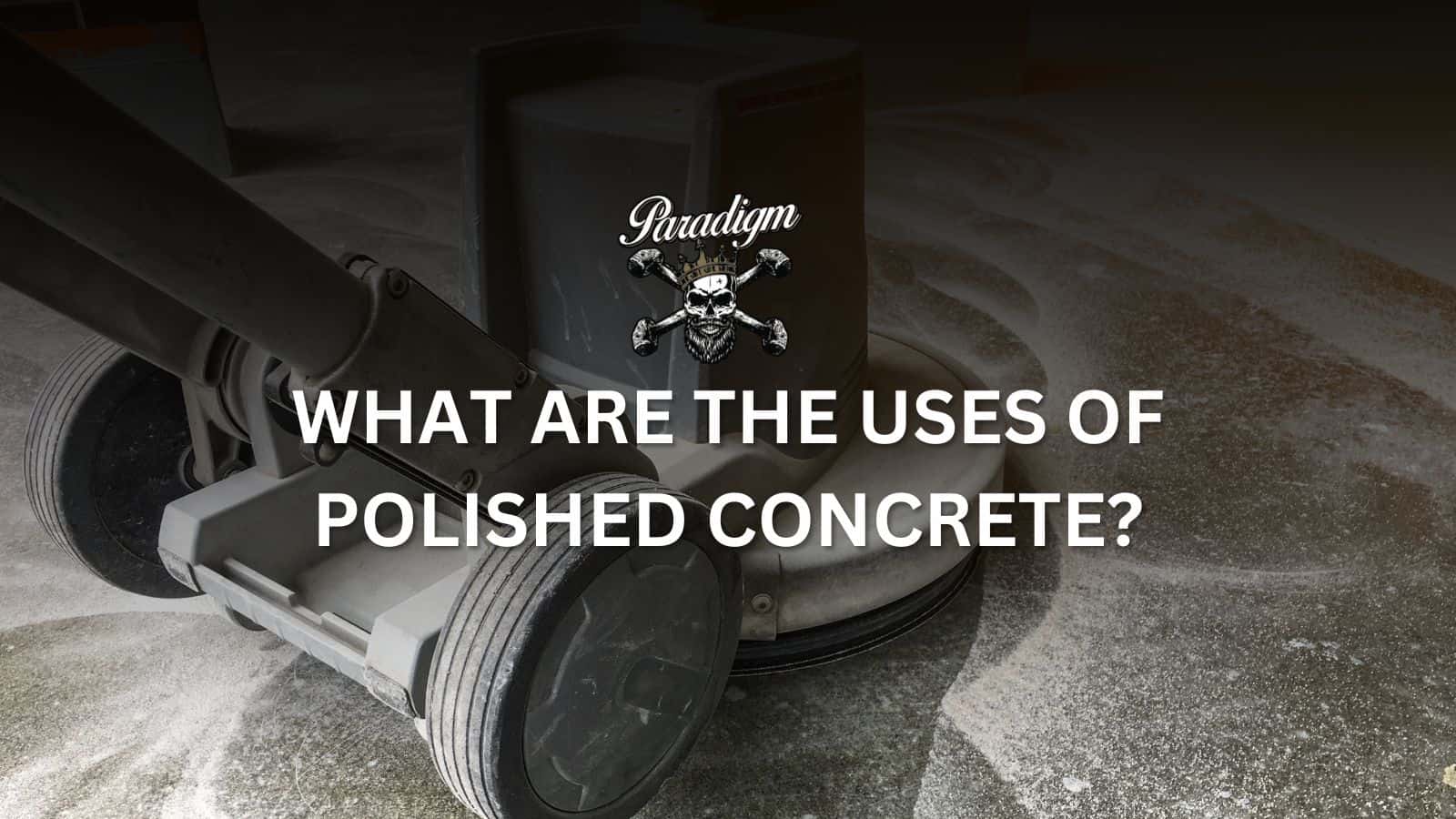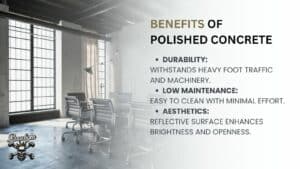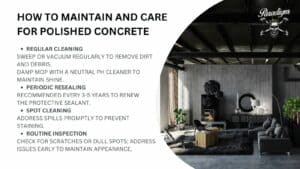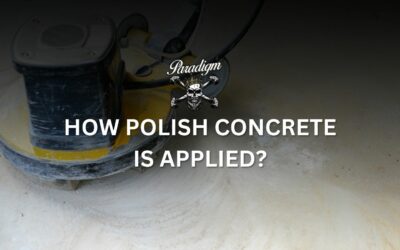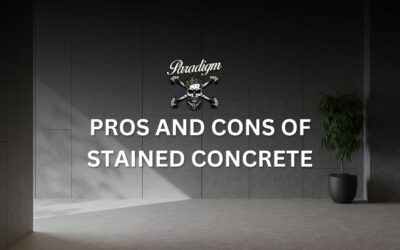If you’re considering a sleek, modern flooring option for your commercial or residential space, polished concrete is likely on your radar. This durable and visually striking surface has grown increasingly popular in recent years, captivating homeowners and designers alike with its glossy, reflective finish.
But have you ever wondered exactly how this polished concrete look is achieved? The process involves several key steps, from the initial preparation of the concrete surface to the final sealing and protection. Understanding these steps can help you appreciate the expertise and care that goes into transforming a simple concrete floor into a true design centerpiece.
Polished concrete has become a common choice for flooring projects and can be used in a wide range of settings, such as commercial spaces and residential homes. If you’re curious about the versatile uses of this durable and visually appealing material, you’re in the right place.
Polished concrete is created through a multi-step process that grinds, hones, and buffs the surface of concrete, resulting in a smooth, glossy, and reflective finish. This process not only enhances the concrete’s aesthetic appeal but also significantly improves its durability and longevity.
One of the primary advantages of polished concrete is its low maintenance requirements. Unlike other flooring options that may require frequent cleaning or replacement, polished concrete is easy to keep clean and can withstand heavy foot traffic with minimal wear and tear. This makes it an attractive choice for commercial settings, such as retail stores, offices, and hospitality venues, where a pristine appearance is crucial.
Table of Contents
What are The Benefits of Polished Concrete?
The main benefits of polished concrete are longevity, low maintenance requirements, aesthetically pleasing appearance, versatility, and increased brightness.
- Durability and Longevity: Polished concrete is an exceptionally durable flooring option that can withstand heavy foot traffic, the use of machinery, and other demanding conditions with minimal wear and tear. Its long-lasting nature makes it a cost-effective choice in the long run.
- Low Maintenance Requirements: Compared to other flooring materials, polished concrete requires relatively low maintenance. It can be easily cleaned with a damp mop or mild detergent, reducing the time and effort needed to keep the surface looking its best.
- Aesthetically Pleasing Appearance: The polishing process reveals the natural beauty of the concrete, creating a sleek, glossy, and reflective finish. This modern, elegant look can enhance the overall aesthetic of a space and complement a wide range of interior design styles.
- Increased Reflectivity and Brightness: The polishing process increases the reflectivity of the concrete surface, which can help to brighten up a room and create a more open, spacious feel. This enhanced reflectivity can also contribute to improved energy efficiency by reducing the need for artificial lighting.
- Versatility: Polished concrete can be used in a variety of settings, from commercial spaces and industrial environments to residential homes. Its adaptability allows for design flexibility and the ability to integrate it seamlessly into different types of projects.
What are the Uses of Polished Concrete?
Polished concrete is a highly sought-after flooring solution in commercial, residential, industrial, educational, and specialized settings.
1. Commercial Spaces
Polished concrete is an excellent flooring option for commercial properties such as retail stores, shopping malls, and office buildings. Its durable and low-maintenance qualities make it well-suited for high-traffic areas, while the glossy, reflective finish can enhance the space’s overall aesthetic appeal.
The sleek and modern look of polished concrete complements the design of many commercial establishments, creating a visually appealing and functional environment for both customers and employees.
2. Residential Applications
Homeowners are increasingly turning to polished concrete for their living spaces, particularly in areas like living rooms, kitchens, and even outdoor patios and walkways. The material’s longevity and easy maintenance make it a practical choice for residential use, while its versatile appearance allows it to blend seamlessly with a variety of interior design styles. Polished concrete can provide a unique, contemporary look that adds visual interest to any home.
3. Industrial and Warehouse Settings
The strength and resistance to wear and tear of polished concrete make it an ideal choice for industrial and warehouse environments. Manufacturing plants, factories, garages, and distribution centers often utilize polished concrete flooring to withstand the demands of heavy machinery, equipment, and constant foot traffic. The durability and low-maintenance requirements of polished concrete make it a cost-effective and practical solution for these types of industrial settings.
4. Educational Institutions
Polished concrete is a popular choice for educational facilities, such as schools, colleges, and universities. Its ability to withstand high foot traffic and its easy-to-clean surface make it a practical flooring option for hallways, classrooms, and common areas. Additionally, the reflective nature of polished concrete can help to brighten up these spaces, creating a more welcoming and visually appealing environment for students and faculty.
5. Automotive Showrooms
The sleek and glossy finish of polished concrete perfectly complements the aesthetics of automotive showrooms. The reflective nature of the material helps to showcase the vehicles on display, creating a sophisticated and visually striking setting. Polished concrete’s durability and low maintenance requirements also make it a suitable choice for these high-traffic commercial spaces.
Specialized Applications of Polished Concrete
Beyond its more common uses in commercial, residential, and industrial settings, polished concrete has a wide range of specialized applications, which include:
1. Decorative Art Installations
The unique and visually striking properties of polished concrete have made it a popular choice for decorative art installations and exhibitions. This means that artists and designers can leverage the material’s reflective qualities, variety of color options, and ability to be sculpted and shaped to create captivating and innovative art pieces.
The smooth, glossy finish of polished concrete provides a striking canvas for artistic expression, allowing for the creation of thought-provoking and visually engaging installations.
2. Healthcare Facilities
The healthcare industry has embraced polished concrete for its sanitary and low-maintenance qualities. Hospitals, clinics, and other medical facilities often utilize polished concrete flooring in areas such as lobbies, hallways, and even some patient rooms.
The seamless and easy-to-clean surface of polished concrete helps to maintain high levels of cleanliness and hygiene, which is essential in healthcare settings. Additionally, the reflective nature of polished concrete can help to brighten up these spaces, creating a more welcoming and calming environment for patients and staff.
3. Religious and Cultural Institutions
Polished concrete has found a place in the design of religious and cultural institutions, such as churches, temples, and museums. The material’s ability to create a sense of grandeur and timelessness, coupled with its durability and low maintenance requirements, make it a suitable choice for these types of spaces. Polished concrete can be used to create visually striking floors, walls, or even sculptural elements that complement the architectural and cultural significance of these buildings.
4. Transportation Hubs
Airports, train stations, and other transportation hubs often utilize polished concrete for its practical and aesthetic benefits. The material’s resistance to wear and tear, as well as its easy maintenance, make it well-suited for the high-traffic and demanding conditions of these public spaces.
Also, polished concrete’s reflective nature can help create a sense of openness and brightness, enhancing travelers’ overall user experience.
How to Maintain and Care for Polished Concrete
Maintaining and caring for polished concrete floors involves a straightforward process to ensure their long-lasting beauty and durability. Here are the key steps to properly maintain polished concrete:
1. Regular Cleaning
Polished concrete floors should be swept or vacuumed regularly to remove any loose dirt, debris, or grit that could potentially scratch the surface. For more thorough cleaning, use a damp mop or auto-scrubber with a neutral pH cleaner specifically designed for polished concrete. Avoid using harsh chemicals or abrasive cleaners, as they can dull the shine and wear down the surface over time.
2. Periodic Resealing
Over time, the protective sealant applied to polished concrete can start to wear down, leaving the surface more vulnerable to stains and damage. It’s recommended that the floor be professionally resealed every 3-5 years, depending on the level of foot traffic and usage. Resealing helps to renew the glossy appearance and protect the concrete from weathering and abrasion.
3. Spot Cleaning
Promptly address any spills or stains on the polished concrete surface. Use a damp cloth or mop to blot the affected area and avoid letting the spill sit and soak in. For more stubborn stains, consult with a professional for the appropriate cleaning products and techniques to avoid damaging the surface.
4. Routine Inspection
Regularly inspect the polished concrete floor for any signs of wear, such as scratches, chips, or dull spots. Tackling these issues early on can help prevent further deterioration and maintain the desired aesthetic.
Hiring professional contractors for the installation and ongoing maintenance of polished concrete floors is often the best decision. At Paradigm Concrete, we specialize in providing top-quality polished concrete services. Our team of experienced technicians can ensure your floors are installed correctly and maintain their beautiful, long-lasting appearance through expert care and maintenance. If you’re looking to start your polished concrete project today, then you should just call us
How long does polished concrete last?
Polished concrete has an impressive lifespan that can extend well beyond 20 years when properly maintained. Its durability is a result of the thorough preparation and finishing processes involved, which create a dense, scratch-resistant surface that is highly resistant to wear and tear.
With regular cleaning, periodic resealing, and proactive maintenance, polished concrete floors can retain their glossy sheen and structural integrity for decades. This makes them a cost-effective and long-lasting flooring solution for a wide range of applications, from commercial spaces to residential homes.
Is polished concrete waterproof?
Yes, polished concrete is considered a waterproof flooring solution when properly installed and maintained.
The grind and seal process used to create polished concrete results in a dense, non-porous surface that is highly resistant to the absorption of water and other liquids. The application of specialized sealers and treatments further enhances the surface’s waterproof properties.
Does polished concrete crack easily?
No, polished concrete does not crack easily. While it is possible for polished concrete to crack in certain circumstances, it is generally considered a very durable and crack-resistant flooring option when installed and maintained properly.
The concrete used in polished flooring is designed to be highly durable and resistant to cracking. The polishing process and application of sealers and hardeners further enhance the concrete’s structural integrity, making it less susceptible to cracking compared to other flooring materials.
Is polished concrete good for the kitchen?
Yes, polished concrete is an excellent choice for kitchen flooring. Its non-porous surface makes it easy to clean and maintain, and it can be customized to complement various kitchen design aesthetics. The versatility and practical benefits of polished concrete make it a popular flooring option for kitchens.

